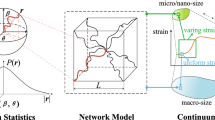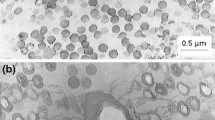Abstract
In this work finite element simulations are used based on the micro structure of polymers in order to transfer the information of the micro level to the macro level. The microscopic structure of polymers is characterized by a three-dimensional network consisting of randomly oriented chain-like macromolecules linked together at certain points. Different techniques are used to simulate the rubber-like material behaviour of such networks. These techniques range from molecular dynamics to the finite element method.The proposed approach is based on a so-called unit cell. This unit cell consists of one tetrahedral element and six truss elements. To each edge of the tetrahedron one truss element is attached which models the force-stretch behaviour of a bundle of polymer chains. The proposed method provides the possibility to observe how changes at the microscopic level influence the macroscopic material behaviour. Such observations were carried out in [1]. The main focus of this work is the validation of the proposed approach. Therefore the model is compared to different experimental data and other statistically-based network models describing rubber-like material behaviour.
Similar content being viewed by others
References
M. Böl and S. Reese, Intern. J. Solids Struct.
R. J. Gaylord, Poly. Engng. Sci. 19(4) (1979) 263.
J. Gao and J. H. Weiner, Macromolecules 24(18) (1991) 5179.
A. S. Lodge, An Introduction to Elastomer Molecular Network Theory (The Bannatek Press, Madison).
M. Wittkop, J. U. Sommer, S. Kreitmeier and D. Göritz, Phy. Rev. E 49(6) (1994) 5472.
T. Hölzl, H. L. Trautenberg and D. Göritz, Phys. Rev. Lett. 79(12) (1997) 2293.
M. Lang, D. Göritz and S. Kreitmeier, Constitutive Models for Rubber III, edited by J. J. C. Busfield and A. H. Muhr (2003) p. 195.
W. Kuhn, Kolloid-Zeitschrift 76(3) (1936) 258.
F. T. Wall, J. Chem. Phys. 10 (1942) 485.
P. J. Flory, and B. Erman, Macromolecules 15(3) (1982) 800.
P. J. Flory and J. Rehner, J. Chem. Phys. 11(11) (1943) 512.
L. R. G. Treloar, Trans. Fara. Soc. 39(1943) 36.
L. R. G. Treloar, ibid. 39 (1943) 241.
E. M. Arruda and M. C. Boyce, J. Mech. Phys. Solids 41(2) (1993) 389.
J. E. Bischoff, E. A. Arruda and K. Grosh, J. Appl. Mech. 69 (2002) 570.
P. D. Wu and E. van der Giessen, J. Mech. Phys. Solids 41(3) (1993) 427.
L. Anand, Comp. Mech. 18 (1996) 339.
W. Kuhn and F. Grün, Kolloid-Zeitschrift 101(3) (1942) 248.
M. Mooney, J. Appl. Phys. 11 (1940) 582.
R. S. Rivlin, Philosop. Trans. Royal Soc. London A240 (1948) 459.
R. W. Ogden, Proc. Royal Soc. London A 326 (1972) 565.
S. R. Swanson, J. Engng. Mater. Technol. 107 (1985) 110.
M. C. Wang and E. Guth, J. Chem. Phys. 20(7) (1952) 1144.
S. Reese and M. Böl, Constitutive Models for Rubber III, J. J. C. Busfield and A. H. Muhr (2003) 213.
L. R. G. Treloar, Trans. Fara. Soc. 40 (1944) 59.
R. W. Ogden, Proc. Royal Soc. London A 328 (1972) 567.
J. C. Simo, Handbook of Numerical Anylysis, vol. III, edited by R. S. Ciarlet and J. L. Lions, Elsevier, Amsterdam.
C. Miehe, S. Göktepe and F. Lulei, J. Mech. Phys. Solids 52 (2004) 2617.
P. Wriggers, Nichtlineare Finite-Element-Methoden (Springer, 2001).
O. L. Zienkiewicz and R. L. Taylor, The Finite Element Method, Vol. I: The Basis (Butterworth-Heinemann).
L. R. G. Treloar, Trans. Fara. Soc. 42 (1946) 83.
L. R. G. Treloar, ibid. 50 (1954) 881.
P. D. Wu and E. van der Giessen, Mech. Res. Commun. 19(5) (1992) 427.
P. D. Wu and E. van der Giessen, Philosop. Magazine A 71(5) (1995) 1191.
Author information
Authors and Affiliations
Corresponding author
Rights and permissions
About this article
Cite this article
Böl, M., Reese, S. Finite element modelling of rubber-like materials — a comparison between simulation and experiment. J Mater Sci 40, 5933–5939 (2005). https://doi.org/10.1007/s10853-005-5058-x
Received:
Accepted:
Issue Date:
DOI: https://doi.org/10.1007/s10853-005-5058-x




